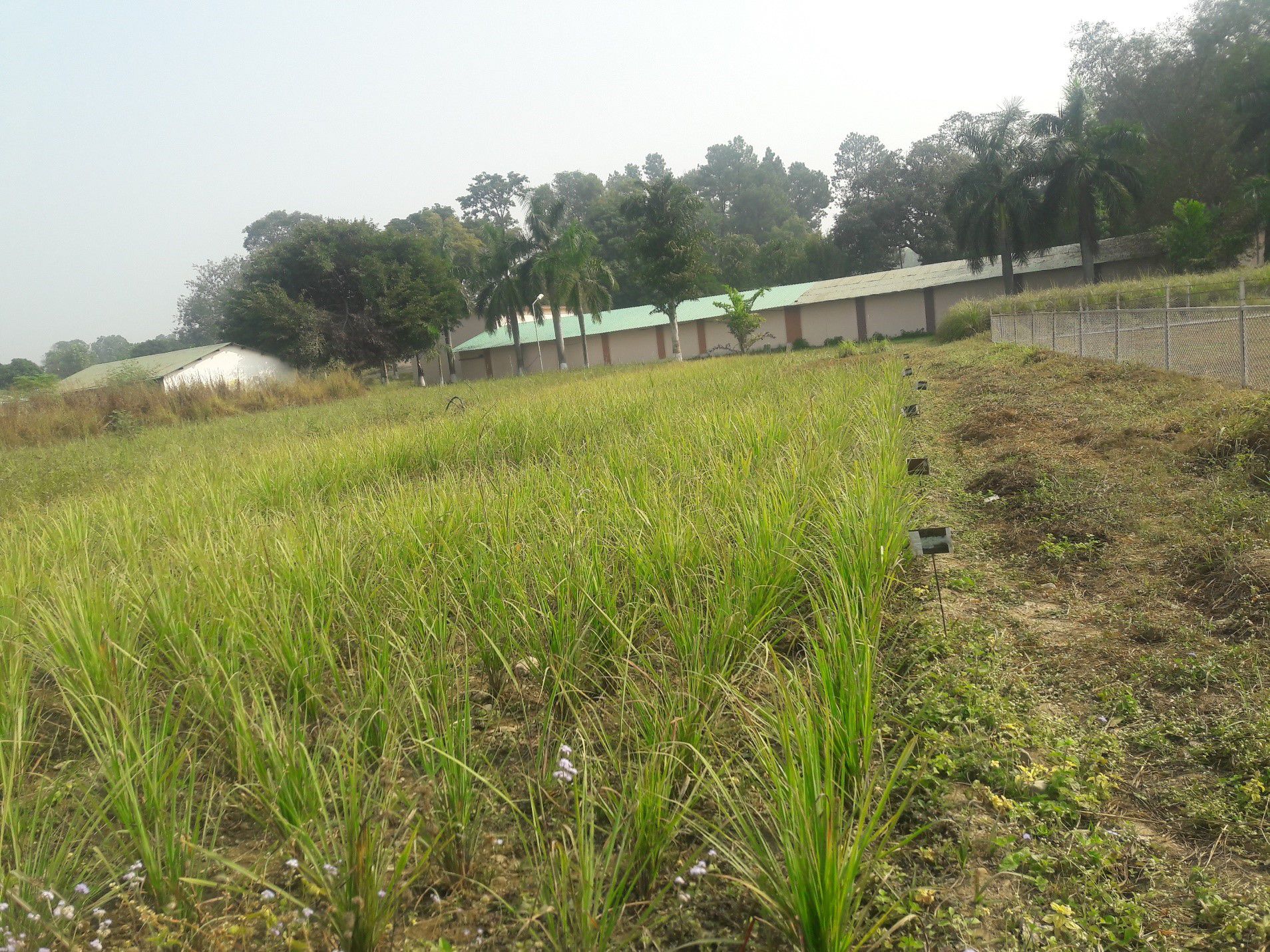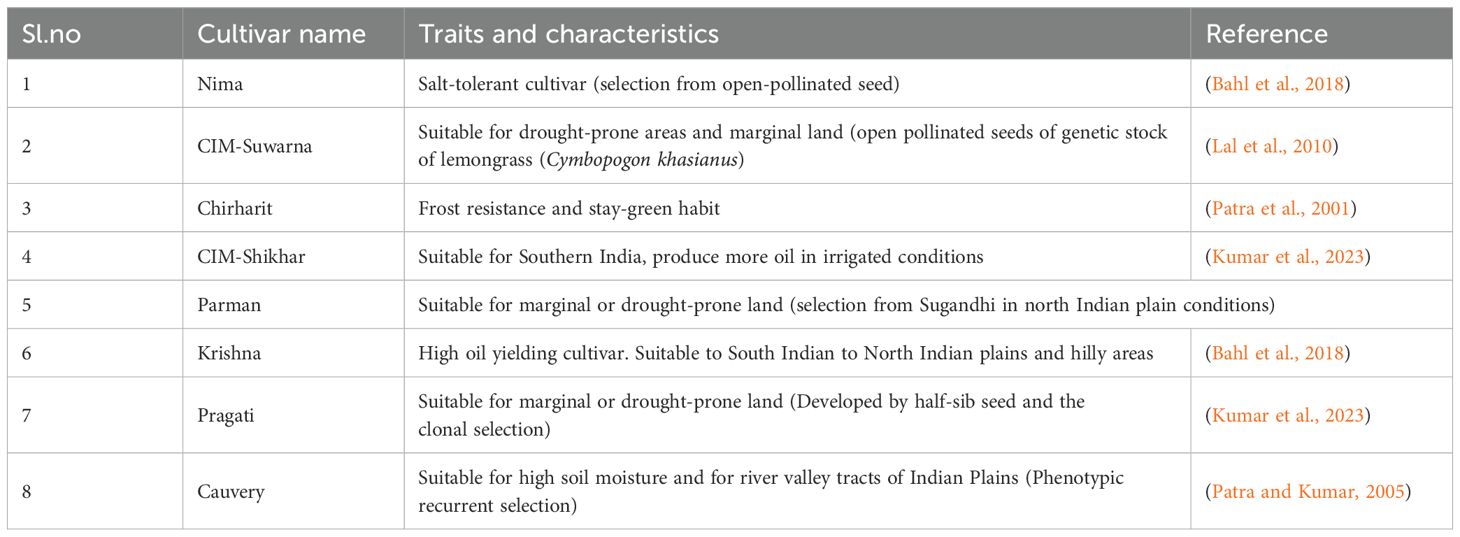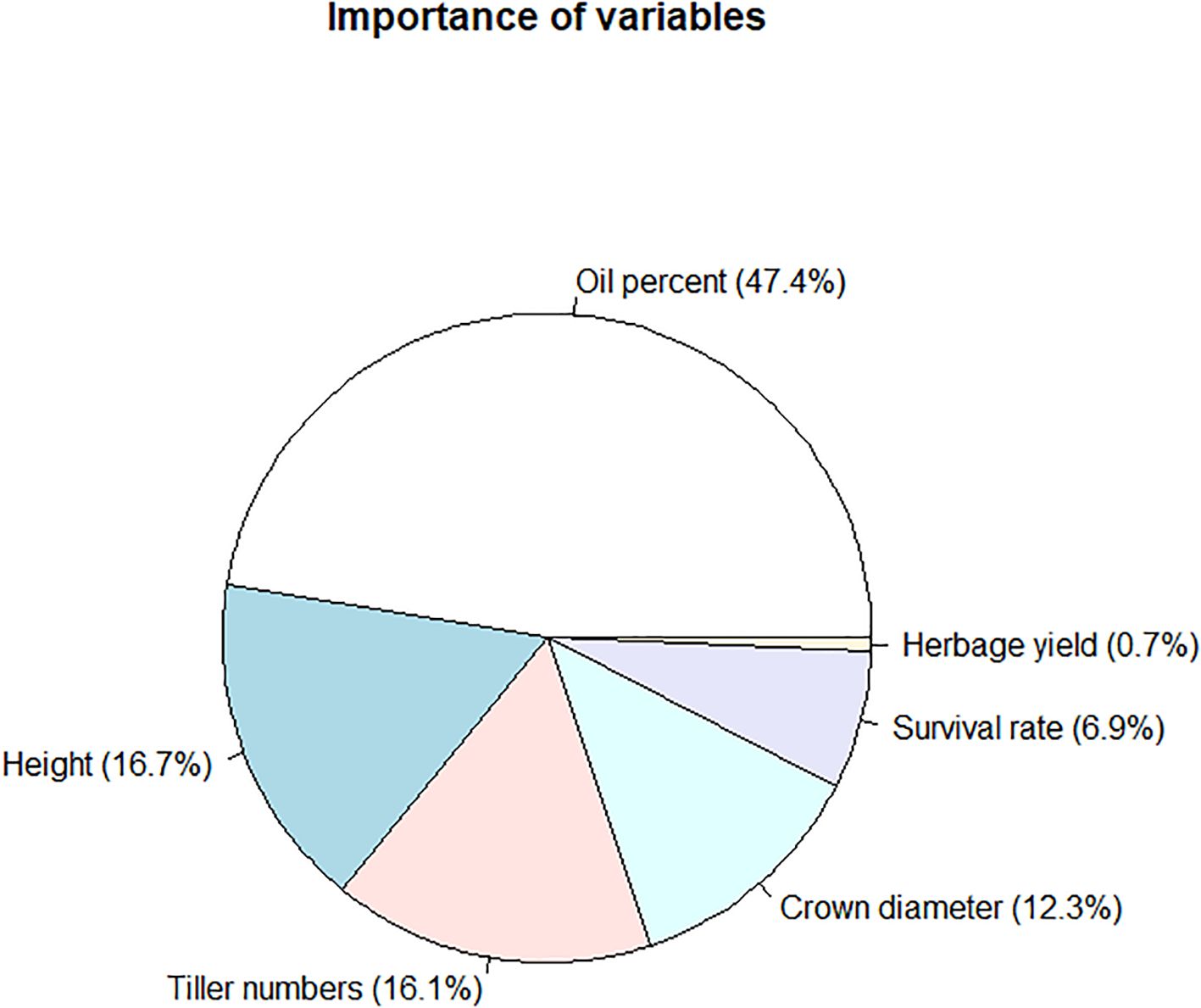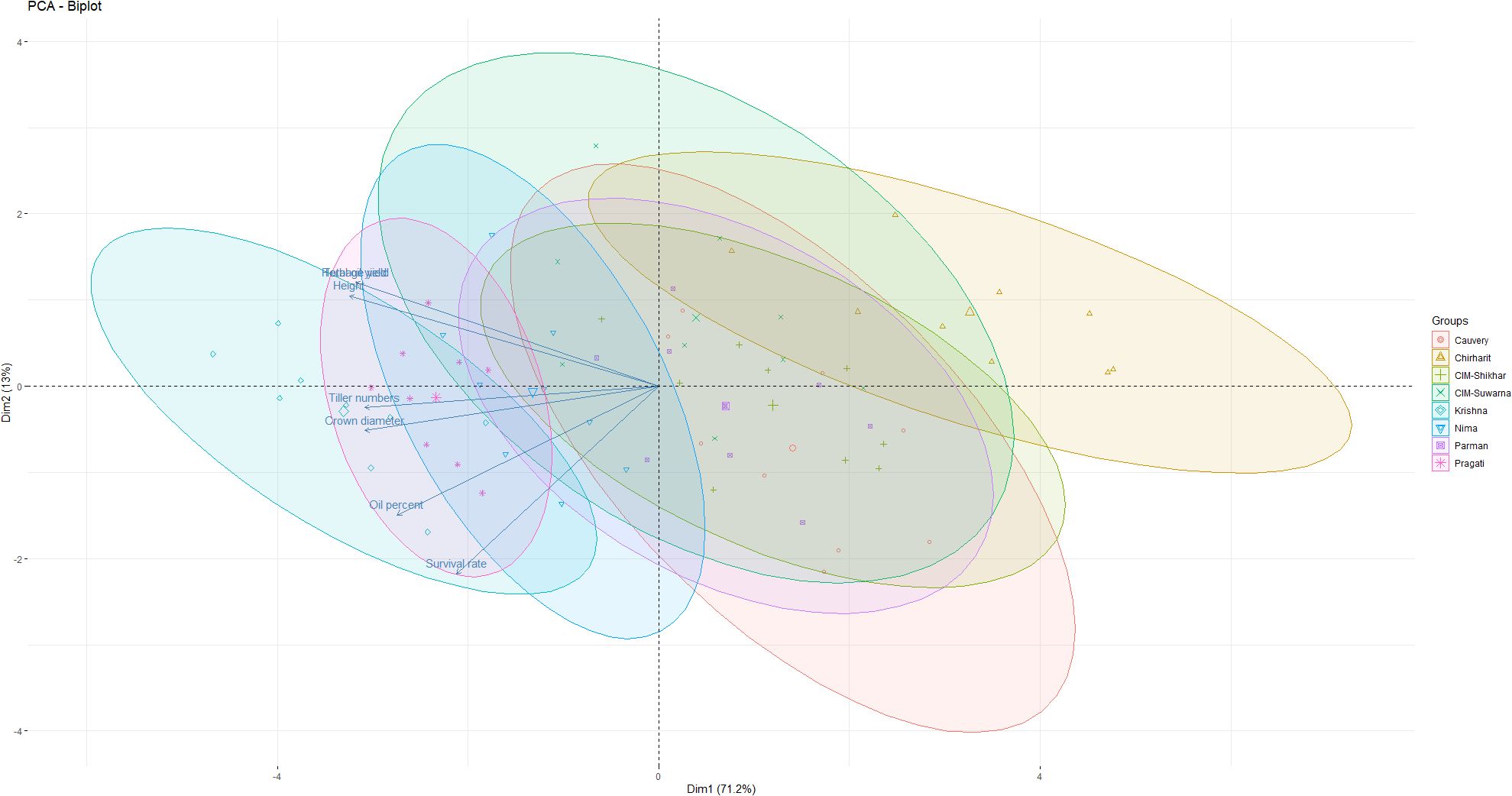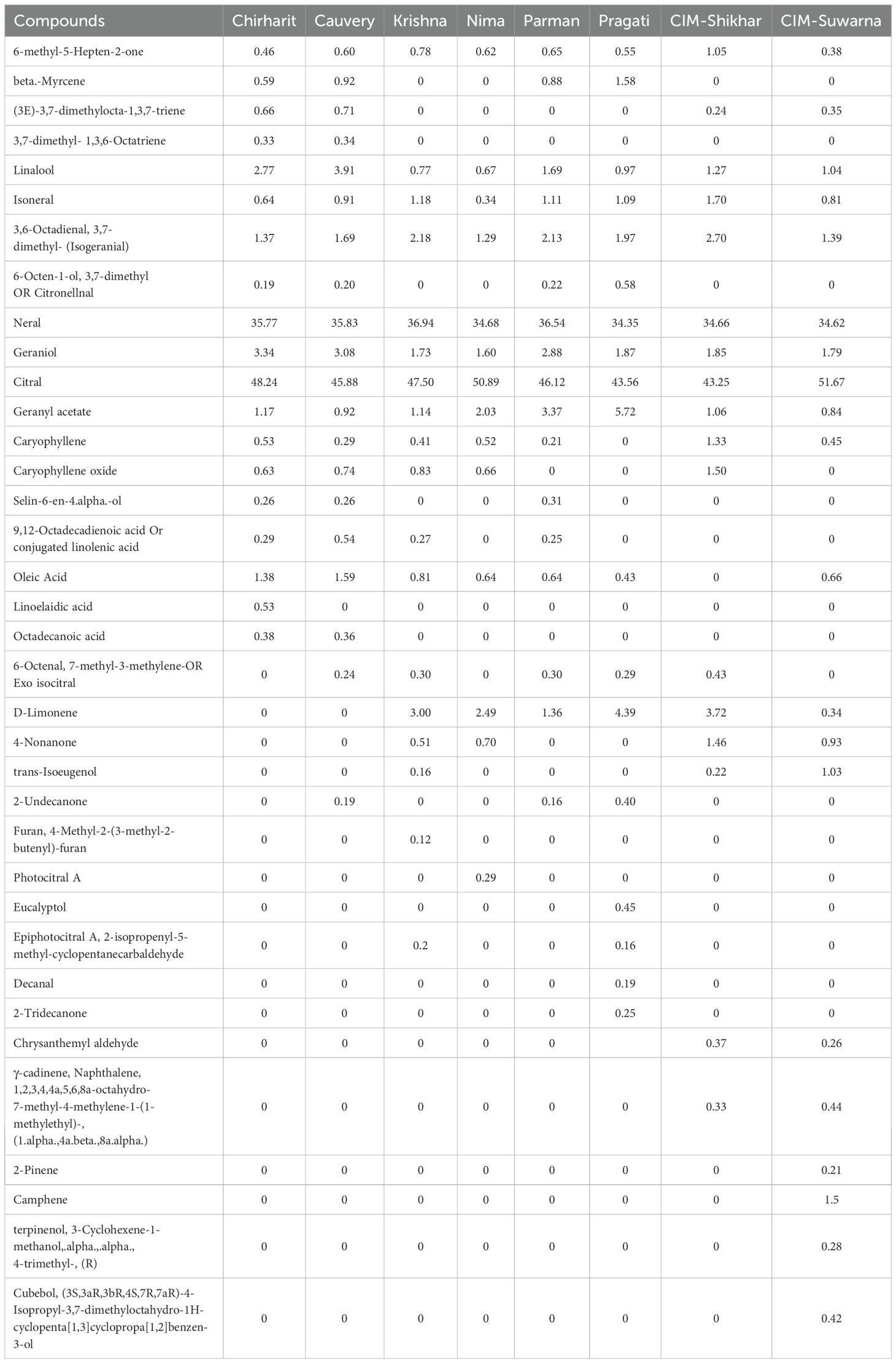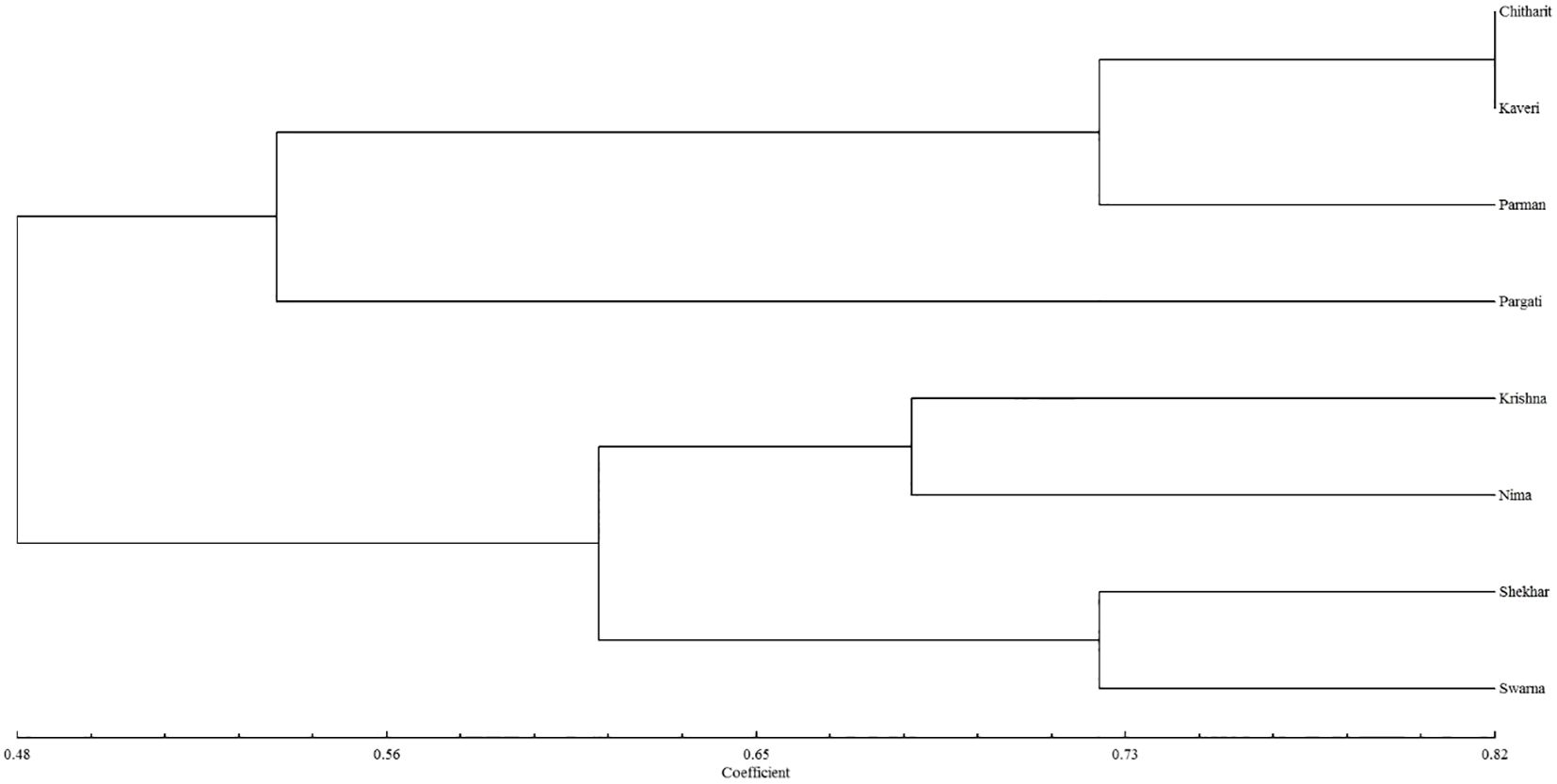- 1Plant Science Division, ICAR-Indian Institute of Soil and Water Conservation, Dehradun, India
- 2ICAR-Indian Institute of Soil and Water Conservation, Research Center, Udhagamandalam, Tamil Nadu, India
- 3Indian Council of Forestry Research and Education, Dehradun, India
Introduction: Lemongrass (Cymbopogon spp.) is an aromatic grass species known for its adaptability to a wide range of agro-climatic conditions. Degraded lands, such as riverbed is present challenges for conventional agriculture. This study aimed to investigate the potential for lemongrass cultivars in riverbed lands at Dehradun.
Methods: The experiment was conducted at ICAR-IISWC Dehradun from 2014 to 2018 on degraded riverbeds. Eight lemongrass cultivars—Cauvery, Chirharit, CIM-Suwarna, CIM-Shikar, Krishna, Parman, Pragati, and Nima—were selected for evaluation. The cultivars were assessed for morphological parameters. Volatile oil was extracted and analyzed using Gas Chromatography–Mass Spectroscopy (GC-MS) to identify chemical constituents and study chemo-diversity among the cultivars. Genetic variability and diversity were also assessed.
Results: The Krishna cultivar recorded the highest herbage yield, followed by Pragati. Krishna also exhibited the highest volatile oil content at 0.55%, with Pragati showing the second-highest value. GC-MS analysis identified Citral is the major constituent of lemongrass with maximum content in the cv. CIM Suwarna (51.67%). Chemo-diversity analysis revealed that, 6-methyl-5-Hepten-2-one, beta Myrcene, (3E)-3,7-dimethylocta-1,3,7-triene, 3,7-dimethyl- 1,3,6-Octatriene, Linalool, Isoneral, 3,6-Octadienal, 3,7-dimethyl, Citronellal, Neral, Geraniol, Citral, and Geranyl acetate are the common constituents found in all the cultivars and also revealed the cultivar specific compounds such as linoelaidic acid in cv. Chirharit; octadecanoic acid in cv. Cauvery and exocitral in cv. Cauvery, CIM-Shikar Krishna, Parman and Pragati. Data on genetic variability indicated that, total volatile oil content and herbage yield traits exhibited the maximum environment coefficient of variation suggesting significant influence from the growing conditions. The experimental findings suggested that the Krishna cultivar is suitable for degraded environmental conditions, thereby contributing to the land degradation neutrality commitments.
1 Introduction
The genus Cymbopogon comprises over 180 species of tropical C4 perennial grasses. Commonly known as Cochin grass, it derives this name from the fact that nearly 90% of its exports are routed through the port of Cochin (Mukarram et al., 2022). Among its species, Cymbopogon flexuosus (Steud.) Wats. (syn. Andropogon nardus var. flexuosus Hack; A. flexuosus Nees) is especially valued for its essential oil, as well as its antioxidant and nutritional properties. It belongs to the family Poaceae and the tribe Andropogoneae. Native to tropical and subtropical regions of India, Indonesia, Madagascar, and several African and South American countries, this species is an important contributor to the global aromatic plant market (Zheljazkov et al., 2011). India is currently the largest exporter of lemongrass (Ghosh, 2022).
Cymbopogon species are particularly well-suited for such environments due to their ability to grow in nutrient-poor soils and adapt to diverse agro-climatic conditions. In India, the cultivation of lemongrass is increasingly being recognized as a viable livelihood option, especially in areas unsuitable for conventional crops (Uniyal et al., 2000; Negi, 2011; Jinger et al., 2020). The plant demonstrates strong tolerance to environmental stresses and has been recommended for land rehabilitation initiatives including the Himalayan riverbeds (Jinger et al., 2021). Its robust root system aids in soil particle binding, helping to prevent erosion and runoff (Jinger et al., 2024). Additionally, fine roots contribute significantly to carbon inputs and improve soil physico-chemical properties (Durán Zuazo et al., 2006; Jinger et al., 2025). Environmental stress conditions can also enhance the production of secondary metabolites (Mahajan et al., 2020).
The plant is widely prized for its aromatic compounds, particularly geraniol and geranyl acetate, which hold significant commercial value. Other key compounds such as citral, citronellol, piperitone and eugenol are commonly used in the fragrance and pharmaceutical industries for their therapeutic properties (Sarkic and Stappen, 2018). The name “lemongrass” originates from its strong lemon-like aroma, primarily due to the high citral content in the essential oil extracted from its leaves (Joy et al., 2007). The principal purpose of lemongrass oil production is to harvest citral-rich essential oil.
Lemongrass leaves are also commonly used to make herbal tea in several countries. Globally, lemongrass essential oil is considered one of the most important essential oils due to its versatility and commercial demand (Ravinder et al., 2010). It is widely used as a flavoring agent in culinary products, including alcoholic and non-alcoholic beverages, frozen desserts, confectionery, baked goods, gelatins, puddings, meats, and edible oils. Lemongrass oleoresin is particularly used to enhance the flavor of food items, beverages, and bakery products (Gawali and Meshram, 2019).
The oil content in lemongrass leaves, typically around 0.8%, is subject to significant variation depending on the species, cultivation method, regional climatic conditions, and timing of harvest. Oil yield tends to be lower during the rainy season and peaks during dry periods, a trend attributed to morphological changes such as shorter leaf length and broader blade width observed in hotter seasons.
Land degradation, defined as the deterioration of soil structure and function, poses a serious threat to agricultural productivity and ecosystem services. It can result in up to a 50% reduction in land productivity (Mahajan et al., 2021). Grasses, due to their extensive root systems, contribute to soil stabilization, reduce erosion and runoff, and enhance soil organic carbon levels. They also offer economic returns to growers, especially on degraded or marginal lands (Tomar et al., 2023).
In India, breeding efforts have primarily focused on increasing productivity, with comparatively less emphasis on stress resilience. Hence, the objective of this study was to evaluate the performance of various lemongrass cultivars on degraded lands and to assess changes in yield and essential oil composition under stress conditions. It was hypothesized that environmental stresses inherent to degraded lands may enhance both the yield and quality of lemongrass and its oil content.
2 Materials and methods
2.1 Study site
The study was carried out at ICAR-IISWC Research Farm, Selaqui. The site is located at 30° 21' N latitude and 78° 52'E longitude at 517 m above msl. The site is Class VI site with bouldary river bed land and soil. Gravels ranging from 0.2 to 10 cm in sizes constitute 60% of the total weight of the contents excavated from a one cubic meter pit. The climate is humid subtropical with average annual rainfall, 1600 mm. During the experiment, the average maximum and lowest temperatures were 19.0-37.6 and 3.6-24.0°C, respectively. The warmest months were May-June (45°C), while December was the coldest (2°C) (Source: ICAR-IISWC Selakui Farm). The experimental location is riverbed wasteland, and the soils are characterised as sandy skeleton typical Ustifluvent. These sites have strong infiltration rates (2.13 to 3.0 cm hr-1) because of their sandy texture and a porous stony layer at lower profile depths.
2.2 Planting materials and observation
Eight lemongrass cultivars viz. Nima, CIM-Suwarna, Chirharit, CIM-Shikhar, Parman, Krishna, Pragati and Cauvery were planted in Randomized block design in nine replications (Figure 1). The description of cultivars along with traits is mentioned in Table 1. Slips were procured from CIMAP, Lucknow. All cultivars were planted with rooted slips at 60 cm × 60 cm spacing to express all the genetic characters. The plot size was 5 m × 2 m which 27 plants accommodated. Lemon grass was planted in 2014. The data of four years were taken and it was harvested in October 2018. The observations on growth and yield parameters in all eight cultivars in 3 clumps were recorded. Data was taken on survival, clump height, clump girth, number of tillers plant-1, crown-spread, total biomass on three randomly selected healthy plants in each replication. Oil yield was recorded at harvesting of grasses by hydro-distillation of fresh herbal biomass using Clevenger apparatus in laboratory. Precisely 1 gram of weighed leaf material was taken, and distilled water was added in a 1:8 (w/v) ratio. The mixture was transferred into a round-bottom flask and connected to the Clevenger apparatus. The water supply to the condenser was initiated to ensure continuous cooling during distillation. The process was continued for 8 hours. The collected oil was then transferred to a rotary evaporator to eliminate any remaining traces of water. The oil was subsequently cooled in a desiccator and weighed accurately. The percentage of essential oil was calculated using the following formula:
Oil content (%) = (Weight of extracted oil/Weight of leaf sample) × 100.
2.3 Statistical analysis
The statistical analysis was carried out using R Studio (version 4.2) and STAR (Statistical Tool for Agricultural Research) software developed by IRRI. Data were first compiled and pre-processed for analysis in R. For mean comparison among treatments, the Duncan’s Multiple Range Test (DMRT) was performed using the agricolae package in R. The DMRT results were used to group means with statistically significant differences, aiding interpretation of treatment effects.
2.3.1 Genetic variability studies
Genetic variability studies were conducted to assess the extent of variability among eight lemongrass cultivars. Key genetic parameters including heritability in the broad sense (H²), genetic advance (GA), genetic coefficient of variation (GCV), phenotypic coefficient of variation (PCV), and environmental coefficient of variation (ECV) were estimated to understand the nature and magnitude of variation for the traits studied. These parameters collectively helped in identifying traits with high genetic control and potential for effective selection (Rasheed et al., 2022).
2.3.2 Cluster analysis and genetic distance
The genetic divergence was calculated using Mahalanobis method. The computation was done for eight cultivars and its traits viz., height, crown diameter, tiller per plant, oil percent, survival rate and herbage yield. The D2 distance was calculated for all possible combinations of eight cultivars. The clusters were formed using Tocher’s method (Rao, 1952). The trait contributing to genetic divergence and their relative importance was calculated using method (Singh and Chaudhary, 1977). Analysis was done using the R studio using Biotool package.
2.3.3 Principal component analysis
The evaluation was performed utilising R Studio, a platform for statistical computing. The PCA computation utilised the prcomp() function, which standardises the data prior to analysis to maintain comparability among variables that have varying units and scales. The results of PCA were subsequently illustrated through the fviz_pca functions available in the Factoextra package in R, offering visual representations within the principal components. The visualisations facilitated the identification of groupings, correlations, and the impact of variables on each principal component.
2.4 GC/MS analysis of volatile oil
GC-MS analysis of the volatile oil was performed on GC 7890B system (Agilent Technologies), coupled with a Mass Spectrometer 5977A (Agilent Technologies; EI 70 eV), and a 7863 automatic injector using a fused silica capillary column DB-5MS UI (30 m x 0.25 mm x 0.25 µm). The GC oven temperature was set to rise from 40°C (4 min hold) to 220°C (15 min hold) at 4°C/min. The injector port and detector temperatures were set at 250°C and 280°C, respectively. Helium (99.995%) was used as a carrier gas with a 1 mL/min flow rate. The injection volume was 1 µL in spiltless mode. Mass spectra were acquired by automatic scanning in the mass range m/z 40 to 300 at 5.1 scan/s. Compounds present in oils were identified by comparison of their mass spectra with those given in the NIST17 and F&F library.
2.5 Chemo-diversity analysis
The chemical diversity of oil was studied by analysing each oil component and marking the presence as 1 and absence as 0 for all cultivars. The data of chemical diversity was analysed using NTsys 2.02. The similarity was estimated using Jaccards coefficient and dendrogram was developed.
3 Results and discussion
3.1 Growth parameters and biomass
To assess the normality of the data, Shapiro-Wilk test was done. The normality of each variable was determined based on the p-values obtained from these tests, with a significance threshold of p > 0.05 indicating normal distribution. All the variables, namely Height, Crown Diameter, Tiller Number, Oil Percent, Survival Rate, Herbage Yield, and Total Oil Yield, exhibited p-values greater than 0.05 for normality tests. This indicates that the distributions of these variables do not significantly deviate from normality. Hence, all variables are normally distributed, and satisfies the assumption of normality required for parametric statistical analyses. The mean of 8 cultivars was analysed for various traits utilising the Duncan multiple range test (DMRT). This test facilitates a comparison of the means across different cultivars to identify the differences based on specific traits (Figure 2). The mean heights of each cultivar differ significantly when cultivated on degraded lands. The recorded heights for Krishna was 137.33 cm, Pragati was 130.72 cm, Nima was 123.88 cm, CIM-Suwarna was 117.63 cm, Parman was 110.86 cm, CIM-Shikhar was 106.75 cm, Cauvery was 102.16 cm, and Chirharit was 96.11 cm (Figure 2). In a similar manner, there was a notable difference in crown diameter among the cultivars planted on degraded lands. Nonetheless, the tiller counts were non-significant for Krishna at 56 and Pragati at 51. A notable similarity in oil percentage was observed among the cultivars Krishna (55 L/t), Pragati (55 L/t), and Nima (53 L/t), as there were no significant differences in oil content among them. Nonetheless, CIM Suvarna (0.42%) and Charharit (0.33%) exhibited significant differences when compared to other cultivars. In terms of oil percentage, Parman, CIM-Shikhar, CIM Suvarna and Cauvery exhibited no significant differences among them. The survival rate of Krishna was the highest at 87.61%, followed by Pragati at 85.77%, and Cauvery at 84.44%, with no significant differences observed among them. In a similar manner, Parman (83.55%) and Shikhar (83.33%) exhibited non-significant differences. In terms of herbage yield, Shikhar (19.57 t ha-1), Suvarna (20.00 t ha-1), and Parman (21.65 t ha-1) exhibited statistically similar results. However, Krishna recorded the highest herbage yield at 27.8 t ha-1, while Pragati (26.57 t ha-1) demonstrated a similar yield to that of Parman. Cauvery (19.01 t ha-1) and Charharit (17.01 t ha-1) exhibit comparable biomass yields. However, Nima (24.38 t ha-1) exhibited a significant difference in biomass yield when compared to other cultivars.
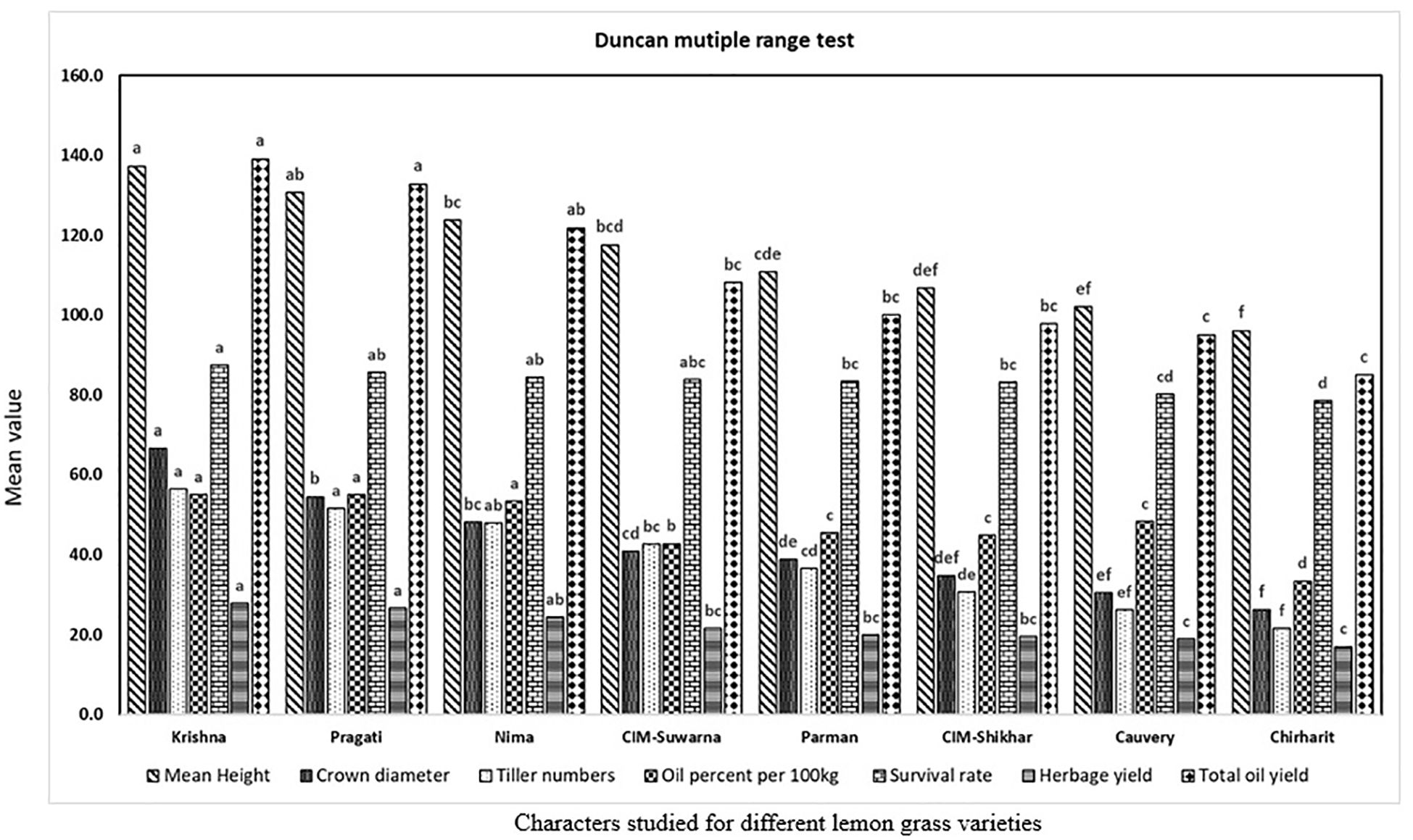
Figure 2. Ducan multiple range test on characters’ studies in eight cultivars of lemon grass. a, b, c and other different letter combination showed significant difference according to Duncan’s Multiple Range Test (p < 0.05). Values with the same letter are not significantly different.
The total oil yield exhibited statistical similarity between Krishna (139.17) and Pragati (132.85), as well as among Suvarna (108.25), Parman (100.03), and Shikhar (97.85). Additionally, a comparable statistical outcome was observed between Cauvery (95.07) and Charharit (85.05). Nima exhibits a notable distinction in comparison to other forming groups, with a value of 121.92. Overall based on conclusive results and on total oil yield and herbage yield, Krishna and Pragati were found best for cultivation on degraded lands. Several other studies have evaluated different lemongrass cultivars for their biomass and oil yield. The Krishna cultivar has shown promising results, with high oil yield of 2.35 L per 100 m² under Himalayan conditions (Verma et al., 2015). Similar study done in Karnataka showed the higher herbage yield of 22.50 t/ha/year in Krishna cultivar (Yogendra et al., 2001). Lemongrass (Cymbopogon spp.) also showed tremendous potential for saline lands in semi-arid regions. Studies demonstrate its ability to grow in calcareous soils using saline irrigation water up to 8.6 dS/m EC. The studies showed that showed better performance Krishna in term of oil content (Dagar et al., 2013). In others study it was reported that lemongrass cultivation improves soil fertility and provides economic returns on degraded riverbed lands (Tomar et al., 2016). Even in drought-prone areas, various cultivars, including Nima, Praman, CIMAP-Suwarna, Krishna, and CIM-Shikhar, have been evaluated for their performance in drought-prone areas, with some showing stability across locations for oil yield and citral content (Singh et al., 2024). Soil characteristics significantly impact lemongrass growth, biochemical properties, and oil yield, with clay loam soil producing the highest citral content in the Krishna (Mehrotra et al., 2023). These findings suggest that lemongrass cultivation can be a viable option for rehabilitating degraded lands while providing economic benefits to farmers in semi-arid regions.
3.2 Genetic variability studies of various cultivars
Genetic variability was estimated for eight lemongrass cultivars on degraded land. The heritability (broad sense) was maximum for oil percentage, which is 91%, followed by crown diameter and tiller numbers, which was 78%. Height was found to have moderate heritability, that is, 66%, and herbage yield survival rate total oil yield showed 48% heritability. The genetic advance showed moderate values for total oil, followed by crown diameter and height along with tiller numbers. Very low genetic advance was reported for oil percentage (0.14). The genetic coefficient of variation was maximum for tiller numbers (31.39), followed by crown diameter (30.84). Low value was shown by survival rate (3.27). The phenotypic coefficient of variation was minimum for survival rate and maximum for tiller number and crown diameter. The environment coefficient of variation was maximum for herbage yield and total oil yield (17.26 each). This indicates that total oil yield and herbage yield followed by crown diameter and tillers number is affected by environmental conditions. Hence these characters are variable under different climatic conditions for different cultivars. In many studies, the cultivars of lemongrass have revealed significant variability. In our study oil percentage showed maximum heritability of 91% and similar was reported by Singh et al., 2005 where high heritability was reported for oil content and yield (Singh et al., 2005).
3.3 Cluster analysis
Multivariate Analysis of Variance (MANOVA) was done for the cluster analysis. During analysis the highly correlated trait total oil content was discarded for analysis. The cultivars showed significant effect (P <2e-16) in MANOVA. However, replications are not having any significant effect. Results revealed the formation of three clusters, with cluster 1 was major cluster and shown the presence of 6 cultivars viz. Nima, CIM- Suwarna, CIM-Shikhar, Cauvery, Praman and Pragati. Cluster 2 and cluster 3 were mono-genotypic with Chirharit and Krishna, respectively. The cluster number 2 and 3 showed highest distance of 184.28 showing most diverse cluster and with large genetic distance. Cluster number 1 and 3 have less distance i.e. 45.4. The inter-cluster distance of cluster number 1 is 21.36 (Figure 3). The relative contribution of traits was calculated. The oil percent was major contributor to the divergence (47.4%), followed by height (16.7%) and tiller number (16.1%). Least contribution was shown herbage yield (0.7%) (Figure 4). Similar cluster analysis was done to find genetic distance in Indonesia (Susilowati and Syukur, 2022). The genetic distance studied in another research showed in lemon grass that cultivated accessions showed more genetic diversity than wild accessions (Shamsheer et al., 2022).
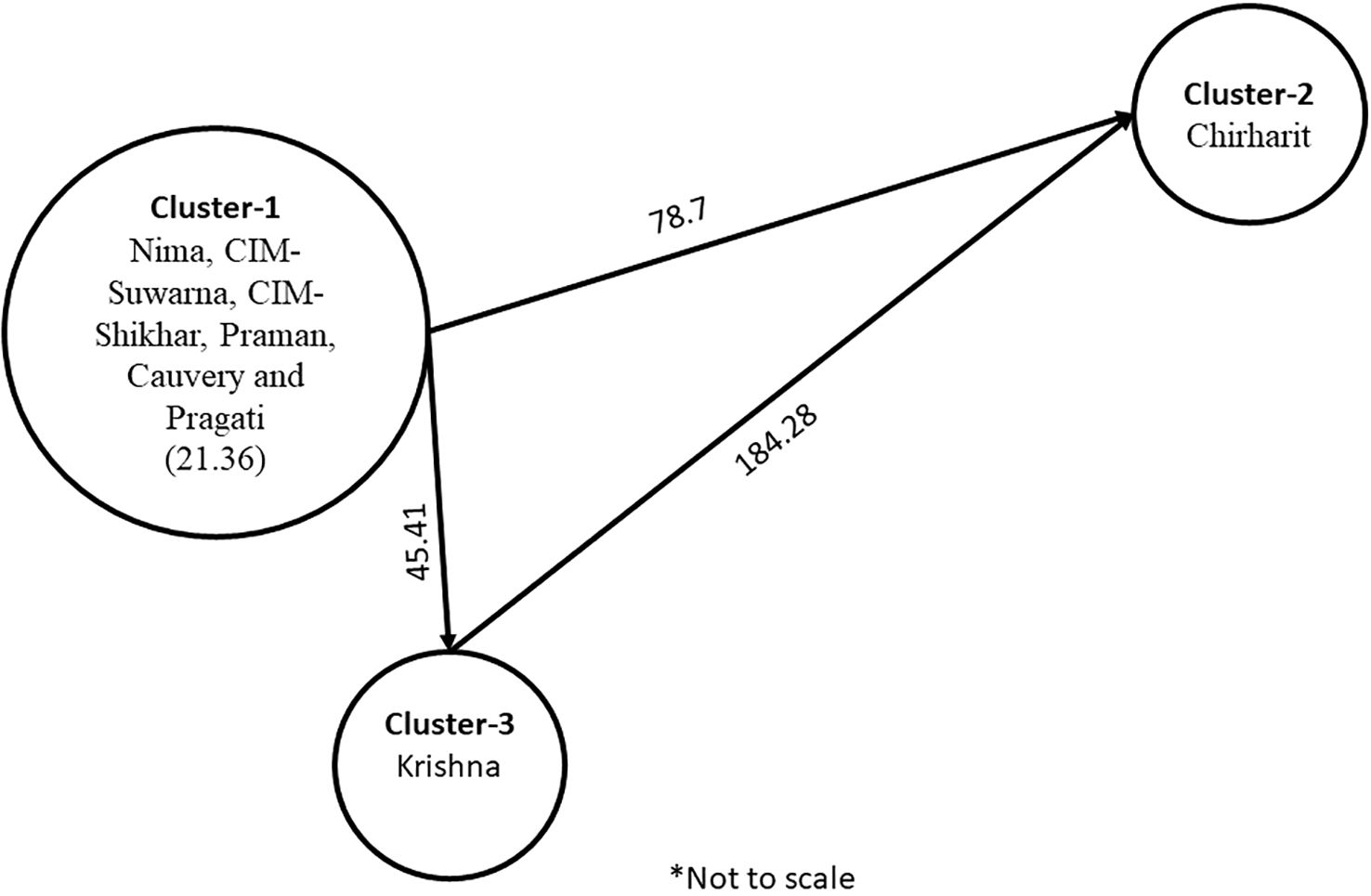
Figure 3. Cluster diagram showing inter cluster and intra-cluster distance of lemon grass cultivars.
3.4 Principal component analysis
Principal component analysis of 8 lemongrass cultivars showed the partition of seven principal components. The PC1 shot 71.2% of variation, followed by PC2 that is 13.02% and PC 3 that was 9.5%. Both PC1 and PC2 capture around 84.2% of variation. The eigenvalue of PC1 was 4.9, and the eigenvalue of PC2 was 0.91. The PCA shows the relation between tiller numbers, crown diameter, oil percentage and survival rate. The close relation was also found between herbage yield, total oil percent, and height. Cultivars Krishna, Pragati, and Nima showed positive relations with all about parameters. However, Chirharit and Shikhar showed negative associations with all about traits. The cultivars such as Parman, Cauvery and Suwarna showed a neutral response to the above trait and showed variations in trait expression. The development of the principal component analysis also showed the superiority of Krishna, Pragati and Nima for yield attributing traits such as biomass, oil yield, tiller number, clump diameter and height (Figure 5).
3.5 Chemical constitution and chemo-diversity of lemon grass cultivars
The chemical constituent’s of oil of all the cultivars was analysed using GC-MS and the major compound found was Citral in all the cultivars (Figure 6; Table 2). It was highest in CIM-Suwarna cultivar (51.67%), followed by Nima (50.89%). The next abundant compound was Neral, which was highest for Nima (36.94%) and Parman (36.54%). Compounds 6-methyl, 5- Hepten- 2 one, beta Myrcene, (3E)-3,7-dimethylocta-1,3,7-triene, 3,7-dimethyl- 1,3,6-Octatriene, Linalool, Isoneral, 3,6-Octadienal, 3,7-dimethyl, Citronellnal, Neral, Geraniol, Citral and Geranyl acetate were present in all the cultivars of the lemongrass. The chemical diversity analysis formed two major groups. The group 1 contain cultivars CIM-Suwarna, CIM-Shikhar, Nima and Krishna. Group two was having Pragati, Parman, Cauvery and Chithrarit. Based on Jaccard 's similarity coefficient, Cauvery and CIM-Suwarna were most dissimilar (0.40) on account of the compound present in the oil of cultivars (Figure 7). Citral was highest percentage of constituent in lemongrass oil. Citral, or 3,7-dimethyl-2,6-octadienal or lemonal is an unsaturated aldehyde, The E-isomer is known as geranial or citral A. The Z-isomer is known as neral or citral B. Citral has antibacterial, antioxidant, anticancer, anti-diabetic, and anti-inflammatory effects (Sharma et al., 2019). Recently its anti-cancerous activity against lung cancer (Sharma et al., 2023). Citral is an aroma component that is used in perfumery. It has a distinct lemon aroma and flavour, is widely used as an addition (Idrees et al., 2019). The maximum citral content was found in CIM-Suwarna (51.67%) followed by Nima (50.89%). The minimum citral content was found in CIM-Shikhar (43.25%) and Pragati (43.56%). The neral content was found maximum in Krishna (36.94%) cultivar and minimum in Pragati (34.35%). The geraniol was maximum for Chirharit (3.34%) and minimum for Nima (1.6%). Geranyl acetate acts as precursor for geraniol (Ganjewala and Luthra, 2009). It is a monoterpene compound with flavours of rose aroma. It was comparatively very high in Pragati (5.72%) and minimum is CIM-Suwarna (0.84%). Isoneral, mostly employed in the pharmaceutical, cosmetic, and food sectors, was also present in the oil extracted from all the cultivars. The maximum content was found in CIM-Shikhar (1.70%) and minimum was found in Nima (0.34%). Sulcatone compound 6-methyl-5-Hepten-2-one was present in all cultivars studied. It is a member of the ketone group. It is highly hydrophobic. The substance emits an aroma reminiscent to citrus in lemongrass. The substance in volatile oil constituent of citronella oil, lemon-grass oil (TMIC Human Metabolome Database: Showing metabocard for Sulcatone (HMDB0035915)). It was found highest in Sikhar and Krishna cultivars. Beta myrcene was found in four cultivars viz. Chirharit, Cauvery, Parman and Pargati. The compound has anti-bacterial and analgesic effect which is reported in lemongrass. The analgesic activity of lemongrass used in form of tea for sedation in ancient medicine literature (Lorenzetti et al., 1991). It is monoterpene compound used in oils, cosmetics and flavouring compounds (Paumgartten et al., 1998). (3E)-3,7-dimethylocta-1,3,7-triene also known as Ocimene possesses the antioxidant effects and prevents the development of various microorganisms (Biosynth FD158989 (3E)-3,7-Dimethylocta-1,3,6-triene, 2023). It was found in four cultivars viz. Chirharit, Cauvery, CIM-Shikhar and CIM-Suwarna. Trans-β-Ocimene was also found in four cultivars: Chirharit, Cauvery, CIM-Shikhar and CIM-Suwarna. It is also monoterpene compound a volatile fragrance compound found in flowering and non-flowering tissues. Its role varied according to source of origin in plants. It invites the natural enemies for insects. It also has a role in plant defence mechanisms (Farré-Armengol et al., 2017). Linalool was present in all cultivars tested and is an aromatic monoterpenoid compound. It is a metabolite perfumery and cosmetic items due to its citrus, fresh, and sweet odour. It is found in many plant families (Elsharif et al., 2015). It also possesses as antibacterial and anti-plasmodial effects. In various animal studies it is found to have the an antinociceptive effects including anti-inflammatory, anti-stress, anti-hyperalgesic anticancer, antimicrobial, neuroprotective, anxiolytic, renal protective, antidepressant and hepatoprotective (An et al., 2021). Limonene compound has a significant ecological role within the plant kingdom, serving as an anti-feedant to deter herbivores, an antifungal agent to combat fungal pathogens, and an attractant for pollinators. It was maximum for the CIM-Shikhar cultivar and was absent in Chirharit and Cauvery (Erasto and Viljoen, 2008). Caryophyllene and Caryophyllene oxide is a volatile bicyclic sesquiterpenoid present in the oils extracted from various plants and spices. It has antioxidant, anti-inflammatory, antibacterial, anti-carcinogenic, analgesic and anti-lipidemic properties (Fidyt et al., 2016; Takemoto et al., 2021). Both compounds found effective against various insects, including common housefly and malarial vector mosquitoes (Mukarram et al., 2021). The maximum concentration of Caryophyllene and Caryophyllene oxide found in CIM-Shikhar and Pragarti while others had the absence of such compounds. Terpineol was found in the CIM-Suwarna only (0.28%), which was reported to have antibacterial effect (Schweitzer et al., 2022). CIM-Suwarna cultivars also have the camphene compound. It is a cyclic monoterpene. The experimental findings indicate that camphene has a potential therapeutic effect in alleviating experimentally induced bronchospasm in animal models. These results imply that camphene may have potential applications in the treatment of chronic obstructive pulmonary disease (COPD) in humans (Russo and Marcu, 2017). 2-Pinene was also found in CIM-Suwarna with 0.21% area. Alpha- and beta-pinene are constituents of pharmaceuticals used in the treatment of renal and hepatic conditions. Furthermore, it has been discovered that α- and β-pinene have inhibitory properties against breast cancer and leukaemia. Additionally, α- and β-pinene have been used as antibacterial agents (Salehi et al., 2019). γ-cadinene and Cubebol was found only in CIM-Shikhar and CIM-Suwarna. 9,12-Octadecadienoic acid was found in only four cultivars (Chirharit, Cauvery, Krishna and Parman) with highest in Cauvery. Oleic acid was not found in CIM-Shikhar while all others had Oleic acid in the oil with the highest in Cauvery. Linoelaidic acid was only found in Chirharit. Octadecanoic acid was found in Chirharit and Cauvery. Exocitral, a perfumery compound, was found in Cauvery, Krishna, Parman, Pargati and CIM-Shikhar with the highest in CIM-Shikhar (0.43%).
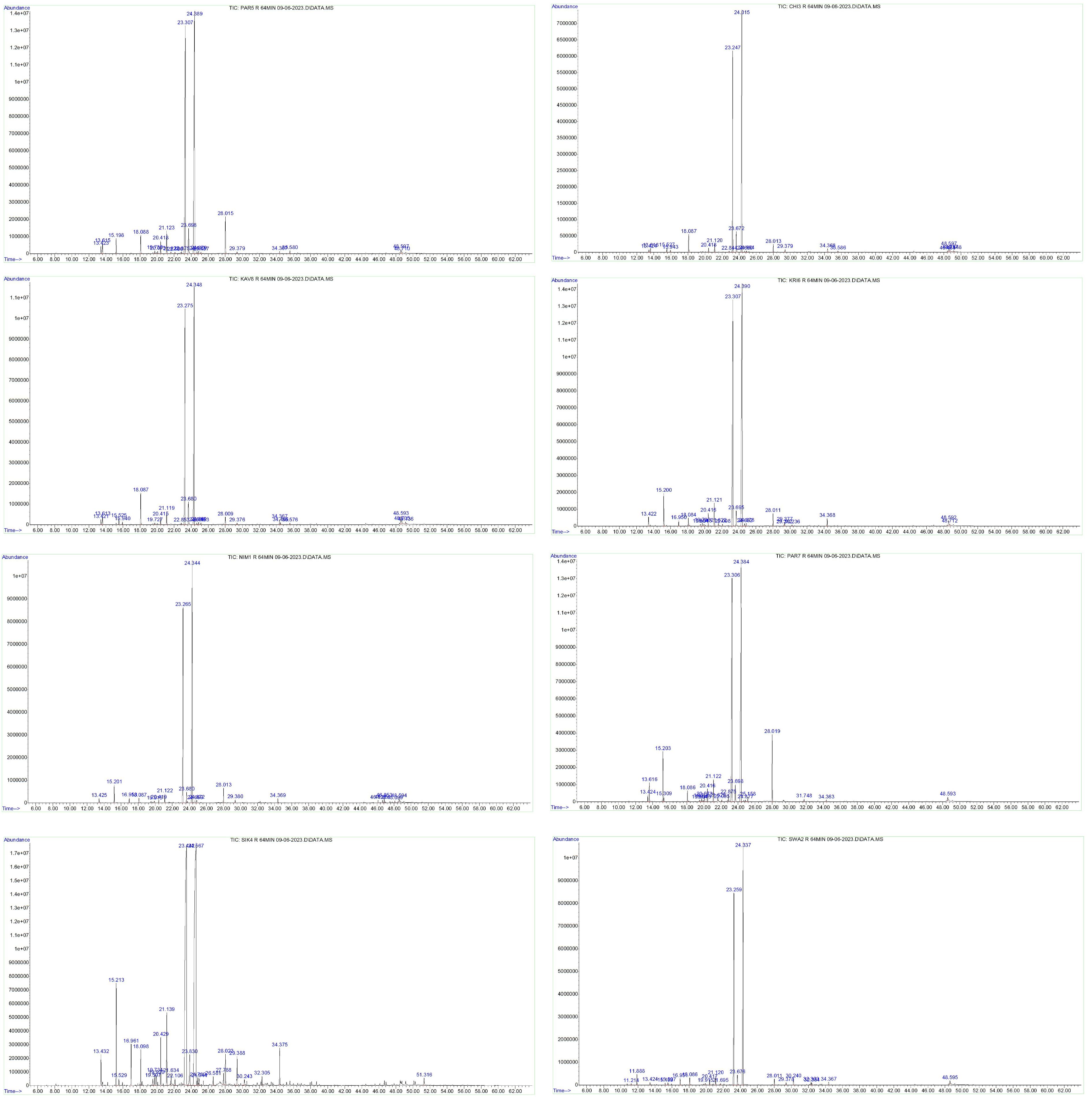
Figure 6. GC-MS profiles of eight cultivars in sequence of Chirharit, Cauvery, Krishna, Nima,Parman, Pargati, CIM-Shikhar and CIM-Suwarna.
In another study GC-MS analysis identified 18 compounds, with citral content varying significantly between accessions (Obaleye et al., 2023). These studies highlight the considerable genetic variability in lemongrass cultivars, providing valuable information for breeding and conservation efforts.
4 Conclusion
Degraded and river side lands are mostly unutilised for the cultivation of crop due to several limiting factors. The lemon grass cultivation is a suitable alternative for the degraded lands. Based on the analysis of growth characters, morphological diversity, principal component analysis, and chemical constitution, it can be concluded that Krishna, Pragati, and Nima are the most suitable cultivars of lemon grass for cultivation in degraded land. These cultivars showed superior performance in terms of yield attributing traits, biomass generation, and oil content. Additionally, the chemical analysis revealed that citral was the major compound found in all cultivars, with CIM-Suwarna having the highest concentration. The cultivars also exhibited chemical diversity, with Cauvery and CIM-Suwarna being the most dissimilar.
Data availability statement
The raw data supporting the conclusions of this article will be made available by the authors, without undue reservation.
Author contributions
JT: Conceptualization, Methodology, Supervision, Writing – review & editing, Writing – original draft, Investigation, Project administration, Funding acquisition, Data curation, Resources, Formal analysis. AB: Writing – original draft, Software, Formal analysis, Visualization, Writing – review & editing, Validation. DR: Conceptualization, Methodology, Project administration, Writing – original draft, Data curation, Investigation, Writing – review & editing. RK: Writing – original draft, Visualization, Investigation, Validation, Writing – review & editing. SKA: Writing – original draft, Visualization, Investigation, Validation, Writing – review & editing. VV: Validation, Writing – original draft, Writing – review & editing, Formal analysis, Software, Investigation, Visualization. MM: Writing – original draft, Supervision, Writing – review & editing, Resources.
Funding
The author(s) declare that no financial support was received for the research, and/or publication of this article.
Acknowledgments
The authors wish to thank Director, ICAR-Indian Institute of Soil and Water Conservation, Dehradun, for providing laboratory facilities and financial assistance under project
Conflict of interest
The authors declare that the research was conducted in the absence of any commercial or financial relationships that could be construed as a potential conflict of interest.
Generative AI statement
The authors declare that no Generative AI was used in the creation of this manuscript.
Any alternative text (alt text) provided alongside figures in this article has been generated by Frontiers with the support of artificial intelligence and reasonable efforts have been made to ensure accuracy, including review by the authors wherever possible. If you identify any issues, please contact us.
Publisher’s note
All claims expressed in this article are solely those of the authors and do not necessarily represent those of their affiliated organizations, or those of the publisher, the editors and the reviewers. Any product that may be evaluated in this article, or claim that may be made by its manufacturer, is not guaranteed or endorsed by the publisher.
Supplementary material
The Supplementary Material for this article can be found online at: https://www.frontiersin.org/articles/10.3389/fagro.2025.1657329/full#supplementary-material
References
An Q., Ren J. N., Li X., Fan G., Qu S. S., Song Y., et al. (2021). Recent updates on bioactive properties of linalool. Food Funct. 12, 10370–10389. doi: 10.1039/D1FO02120F
TMIC Human Metabolome Database: Showing metabocard for Sulcatone (HMDB0035915). Available online at: https://hmdb.ca/metabolites/HMDB0035915 (Accessed 28 Aug 2023).
Bahl J. R., Singh A. K., Lal R. K., and Gupta A. K. (2018). High-yielding improved varieties of medicinal and aromatic crops for enhanced income. New Age Herbals: Resource Qual. Pharmacognosy, 247–265. doi: 10.1007/978-981-10-8291-7_12
Biosynth FD158989 (3E)-3,7-Dimethylocta-1,3,6-triene (2023). Available online at: https://www.biosynth.com/p/FD158989/3779-61-1-3e-37-dimethylocta-136-triene (Accessed 3 Aug 2023).
Dagar J. C., Tomar O. S., Minhas P. S., and Kumar M. (2013). Lemongrass (Cymbopogon flexuosus) productivity as affected by salinity of irrigation water, planting method and fertilizer doses on degraded calcareous soil in a semi-arid region of northwest India. Indian J. Agric. Sci. 83, 734–738.
Durán Zuazo V. H., Martínez J. R. F., Pleguezuelo C. R. R., Martínez Raya A., and Rodríguez B. C. (2006). Soil-erosion and runoff prevention by plant covers in a mountainous area (SE Spain): Implications for sustainable agriculture. Environmentalist 26, 309–319. doi: 10.1007/S10669-006-0160-4
Elsharif S. A., Banerjee A., and Buettner A. (2015). Structure-odor relationships of linalool, linalyl acetate and their corresponding oxygenated derivatives. Front. Chem. 3. doi: 10.3389/FCHEM.2015.00057/BIBTEX
Erasto P. and Viljoen A. M. (2008). Limonene-A review: biosynthetic, ecological and pharmacological relevance. Nat. Prod Commun. 3, 1193–1202. doi: 10.1177/1934578X0800300728
Farré-Armengol G., Filella I., Llusià J., and Peñuelas J. (2017). β-ocimene, a key floral and foliar volatile involved in multiple interactions between plants and other organisms. Molecules 22, 1148. doi: 10.3390/MOLECULES22071148
Fidyt K., Fiedorowicz A., Strządała L., and Szumny A. (2016). β-caryophyllene and β-caryophyllene oxide—natural compounds of anticancer and analgesic properties. Cancer Med. 5, 3007. doi: 10.1002/CAM4.816
Ganjewala D. and Luthra R. (2009). Geranyl acetate esterase controls and regulates the level of geraniol in lemongrass (Cymbopogon flexuosus Nees ex Steud.) mutant cv. GRL-1 Leaves Z Naturforsch. C J. Biosci. 64, 251–259. doi: 10.1515/ZNC-2009-3-417
Gawali A. S. and Meshram N. A. (2019). Scientifically cultivation of lemon grass-a potential aromatic crop. Plant Arch. 19, 2860–2864.
Ghosh A. (2022). India becomes one of the largest exporters of lemongrass’ - Hindustan Times. Hindustan times.
Idrees M., Hakkim F. L., Naikoo G. A., and Hassan I. U. (2019). Recent advances in extraction, characterization, and potential use of citral. Natural Bio-active Compounds 3, 225–236. doi: 10.1007/978-981-13-7438-8_9/COVER
Jinger D., Kakade V. D., Kaushal R., Bhatnagar P. R., Ghosh A., Mahawer S. K., et al. (2025). Nature-based solutions for enhancing soil health and CO2 sequestration in degraded ravine lands through silvo-aromatic system and soil moisture conservation techniques. J. Environ. Manage. 380, 124904. doi: 10.1016/j.jenvman.2025.124904
Jinger D., Kakade V. D., Kaushal R., Dinesh D., Bhatnagar P. R., and Singhal V. (2021). Rehabilitation of degraded lands through different planting techniques in Melia dubia Cav. Food Sci. Rep. 2, 7–9.
Jinger D., Kakade V. D., Singhal V., and Dinesh D. (2020). Lemon grass: A lucrative crop for degraded lands of Central Gujarat. Agric. Environ. E-newsletter 1, 26–29.
Jinger D., Nandha Kumar N., Sirohi C., Verma A., Panwar P., and Kaushal R. (2024). “Agroforestry strategies for integrated soil and water conservation,” in Sustainable agroecosystems - principles and practices. Eds. Meena V. S., Bana R. S., Fagodiya R. K., and Hasanain M. (Intech Open, London, UK), 1–26. doi: 10.5772/intechopen.1005772
Joy P., Mathew S., Skaria B. P., and Mathew G. (2007). Development of lemongrass oleoresin for flavouring (Odakkali Asamannoor (India): Kerala Agricultural University , Aromatic and Medicinal plants research).
Kumar A., Rk L., and Gupta A. K. (2023). Novel chemotypes varieties with high oil yield of lemongrass in India Historical and contemporary development of novel chemotype varieties with high oil of lemongrass in India: A review Article History. J. Medicinal Aromatic Plant Sci. 45, 17–27. doi: 10.62029/jmaps.v45i1.kumar
Lal R. K., Chandra R., Chauhan H. S., Misra H. O., Singh A. K., Srikrishna S., et al. (2010). A high yielding variety of lemongrass (Cymbopogon khasianus) CIMAP Suwarna suitable for water stress/rainfed/marginal land conditions. J. Medicinal Aromatic Plant Sci. 32, 61–63.
Lorenzetti B. B., Souza G. E. P., Sarti S. J., Santos Filho D., and Ferreira S. H. (1991). Myrcene mimics the peripheral analgesic activity of lemongrass tea. J. Ethnopharmacol 34, 43–48. doi: 10.1016/0378-8741(91)90187-I
Mahajan G. R., Das B., Manivannan S., Manjunath B. L., Verma R. R., Desai S., et al. (2021). Soil and water conservation measures improve soil carbon sequestration and soil quality under cashews. Int. J. Sediment Res. 36, 190–206. doi: 10.1016/J.IJSRC.2020.07.009
Mahajan M., Kuiry R., and Pal P. K. (2020). Understanding the consequence of environmental stress for accumulation of secondary metabolites in medicinal and aromatic plants. J. Appl. Res. Med. Aromat Plants 18, 100255. doi: 10.1016/J.JARMAP.2020.100255
Mehrotra R., Lothe N. B., and Verma R. K. (2023). Comparative study on changes in biochemical constituents, yield and quality of lemongrass (Cymbopogon flexuosus) grown under different soil types. Arch. Agron. Soil Sci. 69, 3167–3183. doi: 10.1080/03650340.2023.2210082
Mukarram M., Choudhary S., Khan M. A., Poltronieri P., Khan M. M. A., Ali J., et al. (2022). Lemongrass oil components with antimicrobial and anticancer activities. Antioxidants 11, 20. doi: 10.3390/ANTIOX11010020
Mukarram M., Khan M. M. A., Zehra A., Choudhary S., Naeem M., and Aftab T. (2021). Biosynthesis of lemongrass oil and the underlying mechanism for its insecticidal activity. Medicinal Aromatic Plants: Healthcare Ind. Appl., 429–443. doi: 10.1007/978-3-030-58975-2_18/COVER
Negi I. (2011). Traditional healthcare practices among the villages of Rawain valley. Indian J. Traditional Knowledge 10, 533–537.
Obaleye O. E., Adeyemo O. A., and Adejoke E. (2023). Chemical analysis of essential oil and genetic diversity using ISSR and SSR markers in cultivated lemongrass (Cymbopogon citratus) accessions. Afr. Scientist 24, 63–72. doi: 10.26538/africanscientist.24.1.20230309
Patra N. K. and Kumar B. (2005). “Improved varieties and genetic research in medicinal and aromatic plants (MAPs),” in Proceedings of Second National Interactive Meet (NIM). Medicinal and Aromatic Plants, Lucknow, India.
Patra N. K., Sushil Kumar S. K., Khanuja S. P. S., Shasany A. K., Darokar M. P., Alok Kalra A. K., et al. (2001). Chirharit - a high yielding lemongrass variety with frost resistance, stay-green habit and new chromosomal ploidy status. J. Medicinal Aromatic Plant Sci. 23, 137–140. doi: 10.0/FONT/BOOTSTRAP-ICONS.CSS
Paumgartten F. J. R., De-Carvalho R. R., Souza C. A. M., Madi K., and Chahoud I. (1998). Study of the effects of ß-myrcene on rat fertility and general reproductive performance. Braz. J. Med. Biol. Res. 31, 955–965. doi: 10.1590/S0100-879X1998000700012
Rasheed A., Ilyas M., Khan T. N., Mahmood A., Riaz U., Chattha M. B., et al. (2022). Study of genetic variability, heritability, and genetic advance for yield-related traits in tomato (Solanum lycopersicon MILL.). Front. Genet. 13. doi: 10.3389/FGENE.2022.1030309
Ravinder K., Pawan K., Gaurav S., Paramjot K., Gagan S., and Appramdeep K. (2010). Pharmacognostical investigation of cymbopogon citratus (DC) stapf. Pharm. Lett. 2, 181–189.
Russo E. B. and Marcu J. (2017). Cannabis pharmacology: the usual suspects and a few promising leads. Adv. Pharmacol. 80, 67–134. doi: 10.1016/bs.apha.2017.03.004
Salehi B., Upadhyay S., Orhan I. E., Kumar Jugran A., LD Jayaweera S., Dias A., et al. (2019). Therapeutic potential of α- and β-pinene: A miracle gift of nature. Biomolecules 9, 738. doi: 10.3390/BIOM9110738
Sarkic A. and Stappen I. (2018). Oils and their single compounds in cosmetics—A critical review. Cosmetics 5, 11. doi: 10.3390/COSMETICS5010011
Schweitzer B., Balázs V. L., Molnár S., Szögi-Tatár B., Böszörményi A., Palkovics T., et al. (2022). Antibacterial Effect of Lemongrass (Cymbopogon citratus) against the Aetiological Agents of Pitted Keratolyis. Molecules 27, 1423. doi: 10.3390/MOLECULES27041423
Shamsheer B., Riaz N., Yousaf Z., Hyder S., Aftab A., Iqbal R., et al. (2022). Genetic diversity analysis for wild and cultivated accessions of Cymbopogon citratus (DC) Stapf using phytochemical and molecular markers. PeerJ 10, e13505. doi: 10.7717/peerj.13505
Sharma S., Habib S., Sahu D., and Gupta J. (2019). Chemical properties and therapeutic potential of citral, a monoterpene isolated from lemongrass. Med. Chem. (Los Angeles) 17, 2–12. doi: 10.2174/1573406416666191227111106
Sharma A., Harjai K., Ramniwas S., and Singh D. (2023). Bioactivity of Citral and Its Nanoparticle in AttenuatingPathogenicity of Pseudomonas aeruginosa and ControllingDrosophila melanogaster. J. Nanomater. 11, 4703650.
Singh R. and Chaudhary B. D. (1977). Biometrical methods in quantitative genetic analysis. (New Delhi: Kalyani Publishers)
Singh K. K., Lal R. K., Nanasaheb B. R., Chanotiya C. S., Pant Y., Ahmed S., et al. (2024). Variety × Environment interactions for oil yield and cultivar recommendations of lemongrass in drought-prone areas. Ecol. Genet. Genom 30, 100222. doi: 10.1016/J.EGG.2024.100222
Singh S., Singh H., Singh A., and Tiwari R. (2005). Genetic variability and character association in lemongrass (Cymbopogon flexuosus L. Stapf). J. Spices Aromatic Crops 14, 155–157.
Susilowati M. and Syukur C. (2022). Morphological variations of 20 lemongrass accessions. IOP Conf Ser. Earth Environ. Sci. 974, 12050. doi: 10.1088/1755-1315/974/1/012050
Takemoto Y., Kishi C., Sugiura Y., Yoshioka Y., Matsumura S., Moriyama T., et al. (2021). Distribution of inhaled volatile β-caryophyllene and dynamic changes of liver metabolites in mice. Sci. Rep. 11, 1 11:1–1 11:9. doi: 10.1038/s41598-021-81181-z
Tomar J. M. S., Kaushal R., Rathore A. C., Mandal D., and Chaturvedi O. P. (2016). Yield and soil fertility build up by aromatic grasses on degraded riverbed land of north western Himalayan foothills. Indian J. Agroforestry 18, 66–71.
Tomar J. M. S., Kumar P., Gupta A. K., Kaushal R., and Mehta H.. (2023). Performance of two aromatic grasses grown in association with mulberry trees on degraded land in the north-western Himalayan foothills. Biol. Agric. Horticulture 39, 51–61. doi: 10.1080/01448765.2022.2115399
Uniyal R. C., Uniyal M. R., and Jain P. (2000). Cultivation of medicinal plants in India (Delhi: TRADDIC-India/WWF-India).
Verma R. K., Verma R. S., Chauhan A., and Bisht A. (2015). Evaluation of oil yield and chemical composition of eight lemongrass (Cymbopogon spp.) cultivars under Himalayan region. J. Oil Res. 27, 197–203. doi: 10.1080/10412905.2015.1014936
Yogendra N. D., Nazeer M., Yadav M. K., Baskaran K., Pragadheesh V. S., Jnanesha A. C., et al. (2001). Comparative Morphological Assessment of Lemongrass (Cymbopogon spp.) Cultivars for Oil yield, Chemical Composition and Quality Parameters under Southern region of India. Madras Agric. J. 108, 1–8. doi: 10.29321/MAJ.10.000564
Keywords: degraded lands, cultivar diversity, oil percentage, citral, oil content
Citation: Tomar JMS, Barh A, Rawat D, Kaushal R, Annepu SK, Varshney VK and Madhu M (2025) Assessment of performance and diversity of Lemongrass cultivars (Cymbopogon spp.) cultivated in the foot hills of Himalayan Riverbeds. Front. Agron. 7:1657329. doi: 10.3389/fagro.2025.1657329
Received: 01 July 2025; Accepted: 19 August 2025;
Published: 19 September 2025.
Edited by:
Vijay Singh Meena, Indian Agricultural Research Institute (ICAR), IndiaReviewed by:
Tanmaya Kumar Bhoi, Arid Forest Research Institute (ICFRE), IndiaRajendra Bhanwaria, Indian Institute of Integrative Medicine (CSIR), India
Sabha Jeet, Indian Institute of Integrative Medicine (CSIR), India
Copyright © 2025 Tomar, Barh, Rawat, Kaushal, Annepu, Varshney and Madhu. This is an open-access article distributed under the terms of the Creative Commons Attribution License (CC BY). The use, distribution or reproduction in other forums is permitted, provided the original author(s) and the copyright owner(s) are credited and that the original publication in this journal is cited, in accordance with accepted academic practice. No use, distribution or reproduction is permitted which does not comply with these terms.
*Correspondence: Anupam Barh, YW51cGFtYmFyaDZAZ21haWwuY29t
†Present address: Deepika Rawat, Himmotthan Society, Dehradun, Uttarakhand, India
 Jag Mohan Singh Tomar1
Jag Mohan Singh Tomar1 Anupam Barh
Anupam Barh Rajesh Kaushal
Rajesh Kaushal Sudheer Kumar Annepu
Sudheer Kumar Annepu